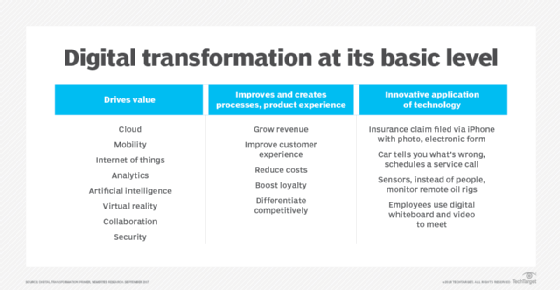
What is business transformation?
Business transformation refers to fundamental changes in an organization's operations, strategy or structure to improve efficiency, competitiveness and financial performance. It can apply to the entire business, a department or a product line.
Unlike incremental improvements, business transformation involves major shifts in processes, technology or business models. Business transformation can involve multiple types of transformational change, such as the following:
- Digital transformation. Leveraging technology, AI and automation to enhance operations.
- Cultural transformation. Changing workplace values, behaviors and leadership styles.
- Organizational transformation. Redesigning hierarchies, teams and workflows.
- Management transformation. Adopting new leadership models, decision-making frameworks or governance structures.
Business transformation initiatives can involve mergers and acquisitions (M&As), staff changes, outsourcing, supply chain reorganization and new business models. The business transformation process typically involves making major changes to an organization's people, processes and technology.
Opportunistic vs. responsive business transformation
Business transformation can be opportunistic or responsive.
Netflix adding a streaming movie service to gain a competitive advantage in a new market is an example of opportunistic business transformation.
The radical changes some companies had to make to support remote work in the wake of COVID-19 restrictions represented responsive business transformation. The reorganization of a supply chain after new trade restrictions is also a responsive approach to business transformation.
This article is part of
The evolving CIO role: From IT operator to business strategist
There are different dimensions of business transformation. Efforts focused on performance improvement include basic business goals such as cost savings and adding new revenue streams. A business portfolio transformation could involve M&As, the creation or termination of product lines, new sales channels and new partnerships.
Technology often plays a central role in transformation initiatives. For example, the implementation of a modern enterprise resource planning (ERP) application, customer resource management (CRM) platform or electronic health records system drives major changes to how business gets done.
Other kinds of transformation, such as outsourcing a business function or terminating an unproductive product line, might have less impact on existing technology or not require new technology.
The role of AI in business transformation
AI is no longer a supporting technology; it's at the core of modern transformation efforts. Applications of AI in business transformation include the following:
- AI-driven automation. Businesses can automate processes beyond traditional robotic process automation (RPA) with hyperautomation, AI copilots and machine learning.
- Predictive analytics. AI forecasts customer demand, optimizes supply chains and improves decision-making.
- Generative AI. GenAI tools like ChatGPT and Gemini generate content, automate customer support and enhance business intelligence.
For example, a retail company can use AI to predict product demand, preventing overstocking and reducing supply chain inefficiencies.
Examples of business transformation initiatives
Initiatives that involve the kind of fundamental change -- and change management -- indicative of business transformation include the following:
- Consolidating operations after M&As.
- Developing AI-powered product lines to meet changing customer demands.
- Shutting down outdated business models and pivoting to digital-first operations.
- Moving Capex products to a subscription-based model, an example of anything as a service or XaaS.
- Consolidating multiple ERP or CRM systems into a unified platform.
- Migrating core business applications to the cloud for scalability or for other reasons.
- AI-driven supply chain optimization for cost reduction and resilience.
- Centralizing risk management functions using AI-based fraud detection.
- Implementing hyperautomation to eliminate manual processes.
- Expanding low-code/no-code platforms to enable nontechnical employees to build applications.
- Enhancing corporate data literacy and AI upskilling programs.
- Implementing data privacy and governance to meet regulatory standards.
- Adopting AI-enhanced cybersecurity frameworks to address threats.
- Shifting sustainability initiatives to meet carbon neutrality goals.
- Implementing outcome-based employee incentive models tied to digital KPIs.
What are the drivers of business transformation?
Many factors can trigger the need for business transformation.
AI, automation and digital transformation
- Companies are investing in AI-driven workflows, automation and analytics to stay competitive.
- Hyperautomation reduces operational costs by integrating AI, RPA and machine learning.
Environmental, social and governance as well as sustainability compliance
- ESG frameworks adopted and championed by governments and investors require companies to meet carbon reduction goals and ethical sourcing standards.
- Supply chains are redesigning for transparency, to achieve a circular economy and to integrate sustainable materials more fully.
Supply chain resilience
- Global trade disruptions, geopolitical risks and deglobalization trends drive onshoring and nearshoring operations.
- Example: The U.S. CHIPS Act incentivizes domestic semiconductor production.
AI-driven customer experience
- Personalization, AI chatbots and predictive customer analytics are transforming customer engagement.
- Example: Netflix's AI-driven recommendation engine enhances user retention.

Steps to implement business transformation
Implementing business transformation should involve these steps:
- Clarify goals. Teams first need to develop clearly defined goals that succinctly state the business transformation's purpose and a theory about what steps could help address these goals.
- Get executive buy-in. Next, enrolling an executive champion to support the goals is essential. This person can help flesh out the initial theory into a more substantive business strategy with specific steps, participants and funding requirements. The champion can also help overcome any hurdles or conflicts around funding, departmental control or communication.
- Develop metrics. The core team needs to clarify what success looks like. What are key metrics to monitor that indicate the work is moving in the right direction? What potential risks could derail the efforts, and how could these be mitigated?
- Get employee buy-in. Once the vision is clear, the core idea must be translated to characterize how it can positively affect employees. This might be as simple as creating a new message and broadcasting it across various corporate channels. Another approach might involve attracting employees to the new vision to help the effort blossom and gain momentum.
- Demonstrate success and build on it. Change of all kinds is hard. Early success on a few pilot implementations can build enthusiasm and buy-in for a new idea across the organization. A center-of-excellence model can consolidate enterprise learnings related to the initiative in a single location and convey success stories that could inspire others to participate.
Best practices for a successful business transformation
Many business transformation efforts fail to reach their goals. A 2018 McKinsey study reported that only 30% of digital transformation efforts succeeded. The group defined success as equipping the organization to sustain performance and equipping the organization to support improvements over time. Prior McKinsey surveys claimed success rates were as low as 20% in 2016 and 2012.
In 2023, the Boston Consulting Group noted a similar trend, while a 2025 Gartner CIO survey revealed that over 50% of digital transformation efforts failed to meet expectations and achieve their desired outcomes. However, BCG found that companies that implement six key practices can significantly increase their chances of successful transformation:
- AI-powered strategy. Align AI adoption with clear business goals.
- Strong leadership buy-in. Senior leaders must sponsor transformation projects.
- Right talent in right roles. Equip teams with AI and digital literacy training.
- Agile execution. Use AI-enhanced decision-making for real-time adjustments.
- Measure and adapt. Continuously analyze AI's impact on business KPIs.
- Composable business models. Shift from monolithic transformations to modular, iterative improvements.
Explore valuable insights into the CIO's key role as a business transformation driver while managing emerging technologies such as AI.





